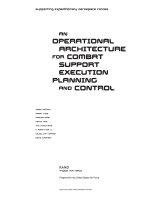Marketing management planning implementation and control richard wilson colin gilligan
Bạn đang xem bản rút gọn của tài liệu. Xem và tải ngay bản đầy đủ của tài liệu tại đây (11.04 MB, 883 trang )
0750659386-Prelims
10/13/2004
11:06am
Page i
Strategic Marketing Management
0750659386-Prelims
10/13/2004
11:06am
Page ii
Dedication
This book is dedicated to the authors’ wives – Gillian and Rosie – and to Ben Gilligan
for their support while it was being written.
Acknowledgements
Our thanks go to Janice Nunn for all the effort that she put in to the preparation of the
manuscript.
0750659386-Prelims
10/13/2004
11:06am
Page iii
Strategic Marketing
Management
Planning, implementation and control
Third edition
Richard M.S. Wilson
Emeritus Professor of Business Administration
The Business School
Loughborough University
and
Colin Gilligan
Professor of Marketing
Sheffield Hallam University
and Visiting Professor, Northumbria University
AMSTERDAM • BOSTON • HEIDELBERG • LONDON • NEW YORK • OXFORD
PARIS • SAN DIEGO • SAN FRANCISCO • SINGAPORE • SYDNEY • TOKYO
0750659386-Prelims
10/13/2004
11:06am
Page iv
Elsevier Butterworth-Heinemann
Linacre House, Jordan Hill, Oxford OX2 8DP
200 Wheeler Road, Burlington, MA 01803
First published 1992
Second edition 1997
Reprinted 1998, 1999, 2001, 2003
Third edition 2005
Copyright © 1992, 1997, 2005, Richard M.S. Wilson and Colin Gilligan. All rights reserved
The right of Richard M.S. Wilson and Colin Gilligan to be
identified as the authors of this work has been asserted
in accordance with the Copyright, Designs and Patents Act 1988
No part of this publication may be reproduced in any material form (including
photocopying or storing in any medium by electronic means and whether
or not transiently or incidentally to some other use of this publication) without
the written permission of the copyright holder except in accordance with the
provisions of the Copyright, Designs and Patents Act 1988 or under the terms of
a licence issued by the Copyright Licensing Agency Ltd, 90 Tottenham Court Road,
London, England W1T 4LP. Applications for the copyright holder’s written
permission to reproduce any part of this publication should be
addressed to the publisher
Permissions may be sought directly from Elsevier’s Science & Technology Rights
Department in Oxford, UK: phone: (ϩ44) 1865 843830, fax: (ϩ44) 1865 853333,
e-mail: You may also complete your request on-line via
the Elsevier homepage (www.elsevier.com), by selecting ‘Customer Support’ and
then ‘Obtaining Permissions’
British Library Cataloguing in Publication Data
A catalogue record for this book is available from the British Library
Library of Congress Cataloguing in Publication Data
A catalogue record for this book is available from the Library of Congress
ISBN
0 7506 5938 6
For information on all Elsevier Butterworth-Heinemann publications
visit our website at
Printed and bound in Italy
Working together to grow
libraries in developing countries
www.elsevier.com | www.bookaid.org | www.sabre.org
0750659386-Prelims
10/13/2004
11:06am
Page v
Contents
Preface
xi
Overview of the book’s structure
1 Introduction
xiii
1
1.1
Learning objectives
3
1.2
The nature of marketing
3
1.3
The management process
1.4
Strategic decisions and the nature of strategy
11
1.5
The marketing/strategy interface
19
1.6
Summary
37
7
Stage One: Where are we now? Strategic and marketing analysis
41
2 Marketing auditing and the analysis of capability
43
2.1
Learning objectives
45
2.2
Introduction
45
2.3
Reviewing marketing effectiveness
50
2.4
The role of SWOT analysis
53
2.5
Competitive advantage and the value chain
70
2.6
Conducting effective audits
71
2.7
Summary
75
3 Segmental, productivity and ratio analysis
77
3.1
Learning objectives
79
3.2
Introduction
79
3.3
The clarification of cost categories
80
3.4
Marketing cost analysis: aims and methods
81
3.5
An illustration of segmental analysis
86
3.6
An alternative approach to segmental analysis
88
3.7
Customer profitability analysis
89
3.8
Marketing experimentation
101
3.9
The nature of productivity
102
3.10
The use of ratios
104
3.11
Analysing ratios and trends
107
3.12
Ratios and interfirm comparison
109
0750659386-Prelims
vi
10/13/2004
11:06am
Page vi
CONTENTS
3.13
A strategic approach
112
3.14
Summary
116
4 Market and environmental analysis
4.1
Learning objectives
4.2
Introduction: the changing business environment
117
119
(or the new marketing reality)
119
4.3
Analysing the environment
120
4.4
The nature of the marketing environment
128
4.5
The evolution of environmental analysis
136
4.6
The political, economic, social and technological environments
139
4.7
Coming to terms with the industry and market breakpoints
149
4.8
Coming to terms with the very different future: the implications
for marketing planning
153
4.9
Approaches to environmental analysis and scanning
159
4.10
Summary
165
5 Approaches to customer analysis
167
5.1
Learning objectives
169
5.2
Introduction
169
5.3
Coming to terms with buyer behaviour
170
5.4
Factors influencing consumer behaviour
174
5.5
The buying decision process
182
5.6
The rise of the new consumer and the implications for
marketing planning
188
5.7
Organizational buying behaviour
192
5.8
The growth of relationship marketing
202
5.9
Summary
214
Appendix: The drivers of consumer change
6 Approaches to competitor analysis
215
221
6.1
Learning objectives
223
6.2
Introduction
223
6.3
Against whom are we competing?
230
6.4
Identifying and evaluating competitors’ strengths and weaknesses
236
6.5
Evaluating competitive relationships and analysing how
organizations compete
241
6.6
Identifying competitors’ objectives
246
6.7
Identifying competitors’ likely response profiles
248
6.8
Competitor analysis and the development of strategy
250
6.9
The competitive intelligence system
251
6.10
The development of a competitive stance: the potential for ethical conflict
255
6.11
Summary
261
0750659386-Prelims
10/13/2004
11:06am
Page vii
CONTENTS
Stage Two: Where do we want to be? Strategic direction and strategic formulation
265
7 Missions and objectives
269
7.1
Learning objectives
7.2
Introduction
271
7.3
The purpose of planning
274
7.4
Establishing the corporate mission
277
7.5
Influences on objectives and strategy
290
7.6
Guidelines for establishing objectives and setting goals and targets
294
7.7
The development of strategies
310
7.8
Summary
313
8 Market segmentation, targeting and positioning
315
8.1
Learning objectives
317
8.2
Introduction
317
8.3
The nature and purpose of segmentation
318
8.4
Approaches to segmenting markets
323
8.5
Factors affecting the feasibility of segmentation
326
8.6
Approaches to segmentation
327
8.7
The bases for segmentation
328
8.8
Geographic and geodemographic techniques
330
8.9
Demographic segmentation
332
8.10
Behavioural segmentation
338
8.11
Psychographic and lifestyle segmentation
341
8.12
Approaches to segmenting industrial markets
345
8.13
Market targeting
347
8.14
Deciding on the breadth of market coverage
350
8.15
Product positioning
353
8.16
Summary
359
9 The formulation of strategy – 1: analysing the product portfolio
9.1
10
271
Learning objectives
361
363
9.2
Introduction
363
9.3
The development of strategic perspectives
363
9.4
Models of portfolio analysis
367
9.5
Market attractiveness and business position assessment
374
9.6
Criticisms of portfolio analysis
379
9.7
Summary
383
The formulation of strategy – 2: generic strategies and the significance
of competitive advantage
385
10.1 Learning objectives
387
10.2 Introduction
387
vii
0750659386-Prelims
10/13/2004
viii
11:06am
Page viii
CONTENTS
10.3 Types of strategy
387
10.4 Porter’s three generic competitive strategies
390
10.5 Competitive advantage and its pivotal role in strategic
marketing planning
10.6 Summary
11
396
423
The formulation of strategy – 3: strategies for leaders, followers,
challengers and nichers
425
11.1
Learning objectives
427
11.2
Introduction
427
11.3
The influence of market position on strategy
427
11.4
Strategies for market leaders
428
11.5
Marketing strategy and military analogies: lessons for market leaders
438
11.6
Strategies for market challengers
447
11.7
Strategies for market followers
461
11.8
Strategies for market nichers
463
11.9
Military analogies and competitive strategy: a brief summary
465
11.10
The inevitability of strategic wear-out (or the law of marketing
gravity and why dead cats only bounce once)
474
11.11
The influence of product evolution and the product life cycle
on strategy
478
11.12
Achieving above-average performance and excellence
484
11.13
Summary
489
Stage Three: How might we get there? Strategic choice
493
12
The strategic management of the marketing mix
495
12.1
Learning objectives
497
12.2
Introduction
497
12.3
Product decisions and strategy
497
12.4
What is a product?
498
12.5
The dimensions of product policy
500
12.6
Brand strategies
505
12.7
The development of new products
510
12.8
Pricing policies and strategies
515
12.9
Approaches to price setting
517
12.10 Deciding on the pricing objectives
518
12.11
520
Methods of pricing
12.12 Using price as a tactical weapon
522
12.13 Promotion and marketing communications
523
12.14 Distribution strategies and the distribution plan
528
12.15 Channel management
528
12.16 The ‘soft’ elements of the marketing mix
534
0750659386-Prelims
10/13/2004
11:06am
Page ix
CONTENTS
12.17 Integrating the elements of the marketing mix
536
12.18 Summary
536
Stage Four: Which way is best? Strategic evaluation
539
13
Criteria of choice
549
13.1 Learning objectives
551
13.2 Introduction
551
13.3 Financial versus non-financial criteria; effectiveness
14
15
versus efficiency
553
13.4 Financial criteria
555
13.5 Non-financial criteria
565
13.6 Multiple criteria
576
13.7 Summary
585
Modelling approaches – 1
587
14.1 Learning objectives
589
14.2 Introduction
589
14.3 Cost–volume–profit analysis
593
14.4 Investment appraisal
610
14.5 Summary
624
Modelling approaches – 2
625
15.1 Learning objectives
627
15.2 Introduction
627
15.3 Allowing for risk and uncertainty
627
15.4 Matrix models
642
15.5 The marketing performance assessment model
648
15.6 Some other approaches to modelling
652
15.7 Summary
664
Stage Five: How can we ensure arrival? Strategic implementation and control
667
16
Problems to overcome
677
16.1
Learning objectives
679
16.2
Introduction
679
16.3
Pressures
680
16.4
Problems in the marketing subsystem
684
16.5
Problems of marketing feedback
688
16.6
Information adequacy
690
16.7
Cost problems
697
16.8
Marketing orientation
703
16.9
Planning orientation
711
ix
0750659386-Prelims
10/13/2004
x
11:06am
Page x
CONTENTS
17
18
16.10 Organizational issues
713
16.11
Summary
721
Management control – 1
723
17.1 Learning objectives
725
17.2 Introduction to control
725
17.3 Control defined
726
17.4 Basic control concepts
728
17.5 Responsibility accounting
734
17.6 Approaches to control
747
17.7 Some behavioural factors
757
17.8 Summary
762
Management control – 2
765
18.1 Learning objectives
767
18.2 Introduction
767
18.3 Controls
767
18.4 Taking corrective action
798
18.5 Management reports
809
18.6 Summary
811
Bibliography
813
Index
853
0750659386-Prelims
10/13/2004
11:06am
Page xi
Preface
In writing the first edition of this book in the early 1990s, we were motivated by a concern to help improve the effectiveness of marketing practice. Twelve years and two editions later, our purpose is unchanged. In doing this, we have sought to address a
number of key questions that logically follow each other in the context of strategic marketing management:
1 Where are we now?
2 Where do we want to be?
3 How might we get there?
4 Which way is best?
5 How can we ensure arrival?
The themes of planning, implementing and controlling marketing activities are
reflected in the answers to these questions – as offered in the eighteen chapters which
follow. The structure of the book is designed to take the reader through each of the
questions in turn. The sequencing of the chapters is therefore significant. We have
sought to build the book’s argument in a cumulative way such that it will provide
guidance in generating effective marketing performance within a strategic framework –
once the reader has worked through each chapter in turn.
Against this background we can specify the book’s aims as being:
➡ To make the readers aware of the major aspects of the planning and controlling of
marketing operations
➡ To locate marketing planning and control within a strategic context
➡ To demonstrate how the available range of analytical models and techniques might
be applied to marketing planning and control to produce superior marketing performance
➡ To give full recognition to the problems of implementation and how these problems
might be overcome.
Since the appearance of the first edition in 1992, the marketing environment – and
therefore the challenges facing marketing planners and strategists – have changed in a
variety of often dramatic ways. Amongst some of the most significant of these changes
has been the emergence of what within this book we refer to as ‘the new consumer’ and
‘the new competition’. This new consumer is typically far more demanding, far more
discriminating, much less loyal and more willing to complain than in the past, whilst
0750659386-Prelims
xii
10/13/2004
11:06am
Page xii
P R E FA C E
the new competition is frequently far less predictable and often more desperate than
previously. At the same time, the marketing environment has also been affected by a
series of unpredictable events (SARS and the Iraq war are just two of the more recent of
these), and by the emergence of new technologies and delivery systems. Together, these
changes have led to a new type of marketing reality which has major implications for
the marketing planning and strategy processes. The question of how marketing planners might respond or, indeed, have responded to the new marketing reality is therefore an underlying theme of this book.
In practice, many marketing planners have responded by focusing to an ever
greater degree upon short-term and tactical issues, arguing that during periods of
intense environmental change, traditional approaches to marketing planning and management are of little value. Instead, they suggest, there is the need to develop highly
sensitive environmental monitoring systems that are capable of identifying trends,
opportunities and threats at a very early stage, and then an organizational structure
and managerial mindset that leads to the organization responding quickly and cleverly.
Within this book we question these sorts of assumptions and focus instead upon
the ways in which the marketing planning process can be developed and managed
effectively and strategically. We therefore attempt to inject a degree of rigour into the
process, arguing that rapid change within the environment demands a more strategic
approach rather than less. We have also introduced a considerable amount of material
designed to reflect some of the areas that have emerged over the past few years and
that currently are of growing importance. The most obvious of these are e-marketing,
branding, the leveraging of competitive advantage and CRM.
It is not intended that this should be used as an introductory text: we have deliberately assumed that readers will have had some prior exposure to marketing principles,
if not to marketing practice. The intended market of the book comprises the following
segments:
➡ Students reading for degrees involving marketing (especially MBA candidates and
senior undergraduates following business studies programmes)
➡ Students of The Chartered Institute of Marketing who are preparing for the
Marketing Planning paper in the CIM’s Diploma examinations
➡ Marketing practitioners who will benefit from a comprehensive review of current
thinking in the field of strategic marketing planning, implementation and control.
Richard M S Wilson
Colin Gilligan
0750659386-Prelims
10/13/2004
11:06am
Page xiii
Overview of the book’s structure
1
Introduction
Stage One
Where are we now?
Strategic and marketing analysis
2
Marketing
auditing and
the analysis of
capability
3
Segmental,
productivity
and ratio
analysis
4
Market
and
environmental
analysis
5
Approaches
to customer
analysis
6
Approaches
to
competitor
analysis
Stage Two
Where do we want to be?
Strategic direction and strategic formulation
7
Missions
and
objectives
8
Market
segmentation,
targeting and
positioning
9
The
formulation
of strategy
–1
10
The
formulation
of strategy
–2
Stage Three
How might we get there?
Strategic choice
12
The strategic management of
the marketing mix
Stage Four
Which way is best?
Strategic evaluation
13
Criteria
of choice
14
Modelling
approaches
–1
15
Modelling
approaches
–2
Stage Five
How can we ensure arrival?
Strategic implementaion and control
16
Problems to
overcome
17
Management
control
–1
18
Management
control
–2
11
The
formulation
of strategy
–3
0750659386-Prelims
10/13/2004
11:06am
Page xiv
0750659386-Chap01
10/13/2004
11:31am
Chapter
Page 1
1
Introduction
0750659386-Chap01
10/13/2004
11:31am
Page 2
0750659386-Chap01
10/13/2004
11:31am
Page 3
INTRODUCTION
1.1 Learning objectives
When you have read this chapter you should be able to:
(a) define marketing in strategic terms;
(b) understand the basic structure of the book and how this chapter establishes the
context for what follows;
(c) specify the characteristics of strategy and strategic decisions;
(d) understand the nature of the debate about the future role of marketing and its
contribution to management;
(e) appreciate the changing emphases within marketing and the implications of these
changes for the ways in which marketing strategies are developed.
1.2 The nature of marketing
The question of what marketing is and what it entails has been the focus of a considerable amount of work over the past 40 years. From this, numerous definitions have
emerged, with differing emphases on the process of marketing, the functional activities
that constitute marketing, and the orientation (or philosophy) of marketing. The
Chartered Institute of Marketing, for example, defines it as:
“
. . . the management process for identifying, anticipating and satisfying customer
”
requirements profitably.
A slightly longer but conceptually similar definition of marketing was proposed by the
American Marketing Association (AMA) in 1985:
“
Marketing is the process of planning and executing the conception, pricing, promotion
and distribution of ideas, goods and services to create exchanges that satisfy individual and
”
organizational objectives.
Although this definition, or variations of it, has been used by a variety of writers (see,
for example, McCarthy and Perreault, 1990; Kotler, 1991; Jobber, 2003), Littler and
Wilson (1995, p. 1) have pointed to the way in which ‘its adequacy is beginning to be
questioned in some European textbooks’ (e.g. Foxall, 1984; Baker, 1987). It could be said
that the AMA definition is more of a list than a definition and is therefore clumsy and
inconvenient to use; that it cannot ever be comprehensive; and that it fails to provide a
demarcation as to what necessarily is or is not ‘marketing’.
They go on to suggest that the AMA definition presents marketing as a functional
process conducted by the organization’s marketing department, whereas the general
thrust of the more recent literature on marketing theory is that marketing is increasingly being conceptualized as an organizational philosophy or ‘an approach to doing
3
10/13/2004
Page 4
S T R AT E G I C M A R K E T I N G M A N A G E M E N T
business’. This strategic as opposed to a functional approach to marketing is captured
both by McDonald (1989, p. 8):
“
Marketing is a management process whereby the resources of the whole organization
are utilized to satisfy the needs of selected customer groups in order to achieve the objectives of both parties. Marketing, then, is first and foremost an attitude of mind rather than
”
a series of functional activities.
and by Drucker (1973), who put forward a definition of marketing orientation:
“
Marketing is so basic that it cannot be considered a separate function on a par with
others such as manufacturing or personnel. It is first a central dimension of the entire business. It is the whole business seen from the point of view of its final result, that is, from
”
the customers’ point of view.
A significant shift in emphasis since Drucker wrote this is to be found in the importance
that is now attached to competitive position in a changing world. Thus, the marketing
concept is that managerial orientation which recognizes that success primarily depends
upon identifying changing customer wants and developing products and services
which match these better than those of competitors (Doyle, 1987; see also Wilson and
Fook, 1990).
The contrasting emphases on customers and competitors can be highlighted as in
Figure 1.1. If an enterprise is managed a little better than customers expect, and if this is
done in a slightly better way than competitors can manage, then the enterprise should
be successful.
Within Figure 1.1 the customer-oriented and competitor-centred categories speak for
themselves. The self-centred category is characterized by an introspective orientation
Minor
Major
Minor
Competitor emphasis
Self-centred
Competitor-centred
Major
4
11:31am
Customer-oriented
Market-driven
Customer emphasis
0750659386-Chap01
Figure 1.1 Customer and competitor orientations (adapted from Day, 1990)
0750659386-Chap01
10/13/2004
11:31am
Page 5
INTRODUCTION
that focuses on year-on-year improvements in key operating ratios, or on improvements
in sales volume without making direct comparisons with competitors. Such an orientation is potentially disastrous when viewed in strategic terms. At the opposite extreme is
a market-driven approach to marketing which seeks to balance a responsiveness to customers’ requirements on the one hand with direct competitor comparisons on the other
(see Illustration 1.1).
Illustration 1.1 But is your organization really
market-driven?
When Peter Drucker first outlined the market-
mentation of the business and competitive
ing concept 50 years ago, he equated mar-
strategy.
keting with customer orientation, arguing
that for a firm to be market-driven meant
Recognition of this has led Webster (1999,
always putting the customer first and inno-
pp. 239–40) to argue that the extent to
vating continuously to improve the delivered
which an organization is market-driven can
value. Subsequently, it has been recognized
be measured against eleven dimensions:
that Drucker’s perspective lacked strategic
content in that it gives emphasis to the organ-
1 The extent to which a customer focus
izational culture, but fails to provide guidance
pervades the entire organization
on which customers to serve and how to
2 The commitment to delivering value
serve them. Equally, Drucker’s initial views
3 The identification and development of
failed to take explicit account of competitors
distinctive competencies
and the discipline of profit in the analysis of
4 The formation of strategic partnerships
product and market opportunity. It is because
5 The development of strong relationships
of this that customer orientation has been
with strategically important customers
replaced with the broader concept of market
6 The emphasis upon market segmenta-
orientation.
Given this, we can see marketing operating
at three levels:
tion, targeting and positioning
7 The use of customer information as a
strategic asset
8 The focus on customer benefits and
1 Marketing as a culture, characterized
service
by a set of values and beliefs that high-
9 Continuous improvement and innovation
lights the importance of the customer’s
10 The definition of quality based on meet-
interests
2 Marketing as a strategy, concerned with
the choice of products, markets and com-
ing customers’ expectations
11 A commitment to having the best information technology available.
petitive stance
3 Marketing as the set of tactics (essentially
For Day (1990), the characteristics of a market-
the seven Ps of the expanded marketing
driven organization can be stated more
mix) that provides the basis for the imple-
succinctly:
5
0750659386-Chap01
10/13/2004
6
11:31am
Page 6
S T R AT E G I C M A R K E T I N G M A N A G E M E N T
➡ An externally orientated culture that
emphasizes superior customer value
➡ Distinctive capabilities in market sensing
as a means of anticipating the future
➡ Structures that are responsive to changing
customer and market requirements.
which found that ‘the single strongest influence on company performance is innovativeness. Further, a market-oriented company
culture was found to have a positive impact in
all five countries, while customer orientation,
by itself, has virtually no influence on bottom
line performance’ (Webster, 1999, p. 241). It
The significance of being market-driven has,
is the recognition of this that, as Webster sug-
in turn, been highlighted by a series of stud-
gests, highlights the need for firms to inno-
ies, including one amongst 600 managers in
vate continuously in order to exceed the
France, the USA, Germany, Japan and the UK,
customer’s evolving definition of value.
Given the nature of these comments, the essential requirements of marketing can
be seen to be (Wilson, 1988b, p. 259):
1 The identification of consumers’ needs (covering what goods and services are bought,
how they are bought, by whom they are bought, and why they are bought)
2 The definition of target market segments (by which customers are grouped according to common characteristics – whether demographic, psychological, geographic,
etc.)
3 The creation of a differential advantage within target segments by which a distinct
competitive position relative to other companies can be established, and from which
profit flows.
The way in which a differential advantage might be achieved – and sustained – is
through the manipulation of the elements of the marketing mix. This mix has traditionally
been seen to consist of the ‘four Ps’ of marketing: product, price, place and promotion.
Increasingly, however, but particularly in the service sector, it is being recognized that
these four Ps are rather too limited in terms of providing a framework both for thinking
about marketing and for planning marketing strategy. It is because of this that a far
greater emphasis is now being given to the idea of an expanded mix which has three
additional elements:
➡ People
➡ Physical evidence
➡ Process management.
The detail of both the traditional ‘hard’ elements of the mix and of the ‘softer’ elements
appears in Figure 1.2; the individual elements of the mix are discussed in Chapter 12 of
this book.
0750659386-Chap01
10/13/2004
11:31am
Page 7
INTRODUCTION
Product
• product management
• new product development
• branding
Process management
• how customers are handled and
managed from the point of very
first contact with the organization
through to the point of very last
contact
Physical evidence
• layout
• decor
• ease of access
The
marketing
mix
People
• employee selection
• employee training
• employee motivation
The four ‘hard‘ Ps
The three ‘soft‘ Ps
Price
• pricing
• discount structures
• terms of business
Place/distribution
• channel management
• customer service
• physical distribution
Promotion
• advertising
• sales promotion
• public relations
• personal selling
• merchandising
• sponsorship
Figure 1.2 The elements of the marketing mix
1.3 The management process
Management can be looked at from a variety of viewpoints. It may be seen from one perspective as being largely an attitude that reflects a willingness to debate issues and
resolve them through the use of appropriate techniques and procedures. Alternatively,
management may be viewed in terms of its responsibility for achieving desired objectives
which requires the selection of means to accomplish prescribed ends as well as the articulation of those ends. This view of management can be analysed further by focusing on
its task orientation (e.g. in the functional context of marketing) or on its process orientation
(i.e. the way in which the responsibility is exercised). In either case it has been suggested
that decision-making and management are the same thing (Simon, 1960, p. 1).
The process of decision-making is rendered problematic on account of the existence
of risk and uncertainty. In the face of risk or uncertainty, some managers postpone making a choice between alternative courses of action for fear of that choice being wrong.
What they typically fail to recognize in this situation is that they are actually making
another choice – they are deciding not to decide (Barnard, 1956, p. 193), which favours
the status quo rather than change. This is not a means of eliminating risk or uncertainty
since it seeks to ignore them rather than to accommodate them: the imperative to adapt
is one that cannot be ignored.
7
0750659386-Chap01
10/13/2004
8
11:31am
Page 8
S T R AT E G I C M A R K E T I N G M A N A G E M E N T
If the central question in the management process concerns the need to make decisions, we need to know what decisions should be made and how they should be made.
This book is intended to deal with both these issues by following a sequence of stages
that reflects a problem-solving routine. Figure 1.3 summarizes these stages.
Stage One (strategic and marketing analysis) raises the question of where the
organization is now in terms of its competitive position, product range, market
share, financial position, and overall levels of capability and effectiveness. In
addressing this question we are seeking to establish a baseline from which we can
move forward.
Stage Two (strategic direction and strategy formulation) is concerned with where
the organization should go in the future, which requires the specification of ends (or
objectives) to be achieved. While top management in the organization will have some
discretion over the choice of ends, this is often constrained by various vested interests,
as we shall see later in this book.
Stage Three of the management process deals with the question of how desired
ends might be achieved, an issue that begs the question of how alternative means to
ends might be identified. This strategy formulation stage requires creative inputs which
cannot be reduced to mechanical procedures.
Introduction
Stage one
Where are we now?
(beginning)
Stage five
How can we ensure arrival?
(control)
Stage two
Where do we want to be?
(ends)
Stage four
Which way is best?
(evaluation)
Stage three
How might we get there?
(means)
Figure 1.3 The framework of the book
0750659386-Chap01
10/13/2004
11:31am
Page 9
INTRODUCTION
Stage Four focuses on the evaluation of alternative means by which the most preferred (or ‘best’) alternative might be selected. The need to choose may be due to alternatives being mutually exclusive (i.e. all attempting to achieve the same end) or a
consequence of limited resources (which means that a rationing mechanism must be
invoked).
Stage Five covers the implementation of the chosen means, and the monitoring of
its performance in order that any corrective actions might be taken to ensure that the
desired results are achieved. Since circumstances both within the organization and in its
environment are unlikely to stay constant while a strategy is being pursued, it is necessary to adapt to accommodate such changes.
Within these stages are to be found the main managerial activities of:
➡ Planning
➡ Decision-making
➡ Control.
The entire sequence of Stages One to Five constitutes control, within which the planning activities are to be found in Stages One to Four. At every stage it is necessary for
decisions to be made, so you will see that these managerial activities are closely intertwined. Moreover, their links are spread across three different time dimensions which
are not of equal significance: the past, the present and the futurre. Let us consider these
in turn.
The past brought the organization (and its products, competitors, etc.) to their present positions. By gaining an understanding of how the organization arrived in its present position, the managers of that organization might develop some insights to help
them in deciding how to proceed in the future. However, there is no way in which the
past can be influenced, so the best one can do is to attempt to learn from it instead of
being constrained by it. If an organization simply continues on unchanging routes its
viability is almost certain to be endangered as the environment changes but it does not.
Stage One is concerned with establishing the ways in which the past brought the
organization to its present position.
The present is transient: it is the fleeting moment between the past and the future
when one must take one’s understanding of the past and link this to the development
of one’s aspirations for the future. Decisions are made (with both planning and control
consequences) in the present, but their impact is intended to be in the future.
The time dimension that is of major relevance in any planning exercise must be the
future rather than the present or the past. There is nothing about an organization that
is more important than its future, and the spirit of this was aptly summarized by
C.F. Kettering: ‘I am interested in the future because that is where I intend to live.’ The
past may help us in deciding how to proceed in the future, but there is no way in which
we can influence the past, so there is a limit to the amount of effort that should be
applied to it as opposed to planning for the future. This is especially relevant when we
consider what a constraint to innovation the past might be: in Goethe’s terms, we see
9
0750659386-Chap01
10/13/2004
10
11:31am
Page 10
S T R AT E G I C M A R K E T I N G M A N A G E M E N T
what we know, and if we are obsessed with carrying on along unchanging routes
we must expect our viability to become endangered as the environment changes but we
fail to adapt to those changes.
On the other hand, the anticipation of the future should not become too fanciful. In
a deliberately extreme mood, De Jouvenal (1967) has stated that:
“
. . . world population, and also the available labour force in industrial countries, is doubl-
ing every 50 years. The GNP is doubling every 20 years, and so are the number of major
scientific discoveries. The whole scientific and engineering establishment, including, for
example, the numbers of graduates, membership of learned societies, and scientific publications, is doubling every 15 years. The money spent on applied research is doubling every
7 years, and so also is the demand for electronics and aviation. If all these processes were
to continue unchecked . . . within about 100 years every one of us would be a scientist,
the entire national output would be absorbed in research, and we should be spending
”
most of our lives airborne at 40 000 feet.
This can be contrasted with a rather more serious comment made by Professor William
H. Pickering of Harvard in a speech made during June 1908, in which his lack of imagination is as extreme as De Jouvenal’s excess:
“
The popular mind often pictures gigantic flying machines speeding across the Atlantic
carrying innumerable passengers in a way analogous to our modern steamship. It seems
safe to say that such ideas are wholly visionary, and, even if the machine could get across
with one or two passengers, the expense would be prohibitive to any but the capitalist
”
who could use his own yacht.
With this uninspired perspective from a member of the establishment in the early
twentieth century, it is not surprising that the vision of writers such as Jules Verne and
H.G. Wells was mocked, yet their premonitions have often come to be justified, with
surprising speed and accuracy in some instances. We did, for example, have Concorde,
despite Professor Pickering’s pessimism.
It should not be expected that any particular vision of the future will be correct in
every detail, nor necessarily very detailed in its conception. Writing in 1959, Drucker
made the rather careless statement that ‘. . . if anyone still suffers from the delusion that
the ability to forecast beyond the shortest time span is given to us, let him look at the
headlines in yesterday’s paper, and then ask himself which of them he could possibly
have predicted 10 years ago’. What Drucker does not take into account is the vital level
of resolution: our interest over a 10-year period may be more in the continued existence
of The Times, or even of a free press, than in specific headlines, because the level of resolution would have to be relatively low (i.e. broad horizons, broad view, little detail).
A balance must be maintained in dealing with the short-run future on the one hand
and the long-run future on the other. Apart from headlines in The Times we can note the
short-run preoccupation in the UK with financial results and contrast this with the
longer-run relevance of market-building strategies, or the risk of being obsessed with
tactics to the exclusion of a proper concern for strategy.








![vmware esxi [electronic resource] planning, implementation, and security](https://media.store123doc.com/images/document/14/y/ki/medium_kik1401475481.jpg)
